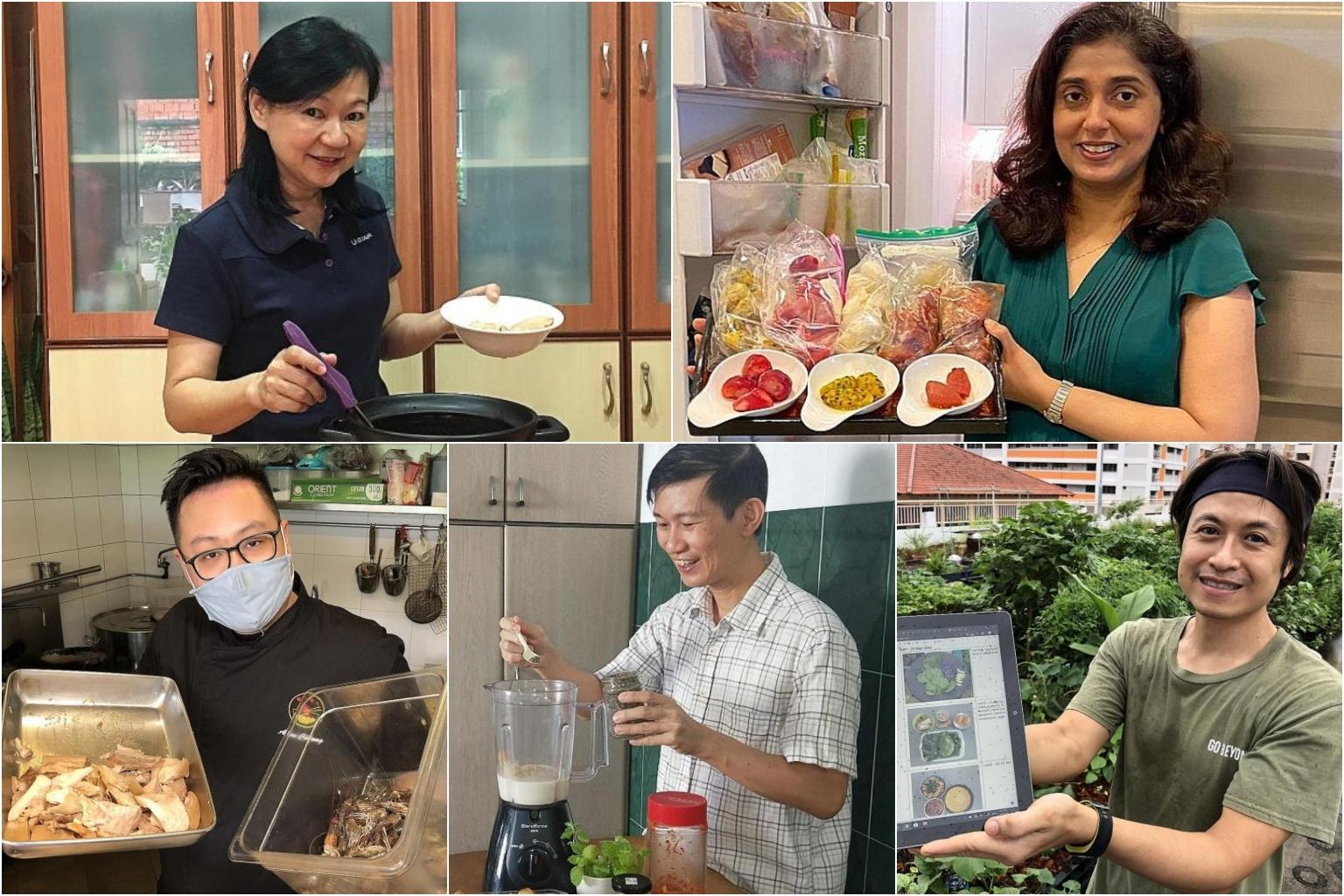5 tips on reducing food waste
The Sunday Times speaks to a housewife, a restaurant owner, a hawker chef and two environmental educators
Sign up now: Weekly recommendations for the best eats in town

(Clockwise from top left) Housewife Jenny Tan; Ms Chitra Mirpuri, owner and director of North Indian restaurant Shahi Maharani; Mr Ong Chun Yeow, who runs a start-up that conducts programmes to raise environmental awareness; environmental educator Tan Hang Chong; and hawker Alan Choong.
PHOTOS: JENNY TAN, CHITRA MIRPURI, HEDY KHOO
Follow topic:
1 TURN LEFTOVERS INTO A NEW DISH
When housewife Jenny Tan cooks soup for her family, she does not let the ingredients go to waste.
Instead of discarding the chicken breast meat used for boiling the soup, she saves it for another dish the next day.
The 54-year-old, who has two sons aged 18 and 22, says: "Not everyone likes to eat the chicken meat in the soup as it tastes bland after boiling."
She shreds the meat and stir-fries it with fresh red finger chilli or sambal chilli paste, garlic, onion, seasoning it lightly with salt to make a lunch dish.
Another tip is to cook enough soup for lunch the next day too.
"In the past, when I cooked soup for dinner, we usually had a leftover amount that couldn't even fill one bowl. It ended up getting thrown out," she says.
"Now, I cook enough to get one or two extra bowls of soup so that any one of us can have it for lunch. This way, nothing goes to waste."
2 FREEZE PERISHABLE FOODS TO EXTEND THEIR SHELF LIFE
Ms Chitra Mirpuri, owner and director of North Indian restaurant Shahi Maharani, practises reducing food waste at her restaurant and at home.
The 44-year-old says: "I was brought up in a family where awareness of and controlling food wastage was inculcated at a young age. My mother would not allow me to waste food on my plate and her motto was to take only what you can finish. This is what I have imparted to my kids too."

At her restaurant, menus are planned such that slow-moving items are removed.
She says: "Our staff are trained to let customers know if they are over-ordering. Even though more orders mean better revenue, we feel it is not only unfair to customers, but also very wasteful."
At home, she saves perishable food such as mango, blueberries, fresh chillies and tomatoes from the bin by blending them into a puree and freezing them in ice-cube trays.
She then packs the frozen cubes into resealable freezer-friendly bags, labels and dates them.
She usually uses the frozen fruit for smoothies within three months. She says: "It does take discipline and effort to puree, freeze, label and store the food properly. But if you freeze food, forget about it and don't use it, then it is also wasted."
3 KEEP A FOOD DIARY
Keeping a food journal for two weeks allowed Mr Ong Chun Yeow, 44, to have a clearer picture of his daily diet and nutritional needs. It also helped him plan his meals to reduce food and packaging waste.
Mr Ong, who runs a start-up that conducts programmes to raise environmental awareness, is also a certified trainer in edible gardening and teaches people how to integrate edible gardening into residential design.
Originally, the aim of the diary, which he kept from May 23 to June 6, was to keep track of the harvest from his edible garden and how the vegetables contribute to his daily meals.
The idea came from a friend at Foodscape Collective, a community for sustainable food systems.
Over the two weeks, he took pictures of what he harvested, the ingredients he used for each meal and the dishes he used them for.
The diary motivated him to plan his meals two or three days ahead. This in turn helped him better gauge the amount of ingredients he had to buy, manage his food stock at home and avoid buying excess items.
He says: "Even if you do not grow your own vegetables or eat out most of the time, keeping a food diary can help you keep track of how much food you can consume and avoid ordering or buying more food than you need."
4 PLAN YOUR MEALS BASED ON WHAT YOU HAVE
Instead of buying new ingredients for a specific recipe, environmental educator Tan Hang Chong says it is more practical to plan meals based on what you already have at home.
The 46-year-old, a founding member of Foodscape Collective, says: "People tend to buy ingredients for a meal they want to cook, but this usually results in surplus ingredients. Try to use up those ingredients first."
He recommends YoRipe, a curated cooking community app which provides recipes based on ingredients you have at home, as well as creative ways to turn common kitchen scraps such as fruit peels and vegetable skins into stock, tea or snacks such as Candied Orange Peel.
For instance, his mother turns leftover cabbage and carrot into kimchi.
His other tips include avoiding shopping when you are hungry and planning your grocery shopping lists.
Reducing food wastage is a practice he adopted as a young man, starting with buying reduced-to-clear food 20 years ago. This also helps cut down his grocery bill.
It is important, he says, to be more informed about date labelling on food items and discard only food that is truly inedible.
He also shares food with his neighbours and accepts excess food from them, such as overripe bananas. "Overripe bananas may look ugly and mushy, but they are very sweet. I usually freeze them and use them for smoothies," he says.
There are also sharing platforms, such as Facebook groups and apps, which connect people who have useful items, including extra food, to give away.
5 FULLY UTILISE INGREDIENTS YOU HAVE
Reducing food waste goes hand in hand with managing operating costs for Mr Alan Choong, 25, who sells prawn mee at his stall in Pasir Ris Central Hawker Centre.
Even before the coronavirus, Prawnaholic's owner had been grappling with the rising cost of pork, sparked by the African swine fever, which affected pork production last year.
To fully utilise a cut of pork belly meat, he slices up the best-looking and tastiest portions for serving with his prawn noodles. The meat scraps go into his stock pot of prawn and pork bone broth for extra flavour.
He learnt not to let ingredients go to waste from his experience of working in celebrity chef restaurants.
He says: "While we save the best cuts for the customers, the scraps can be used to cook another dish or go into cooking staff meals."
While it is common practice to fry prawn heads and shells for boiling stock, Mr Choong takes the extra step of straining the shells after frying. This is to extract the prawn shell-infused oil to make his own prawn oil mayonnaise.
"For food businesses, it makes economic sense to find creative ways to re-use or fully use ingredients. But home cooks can also save money by reducing food waste," he says.

